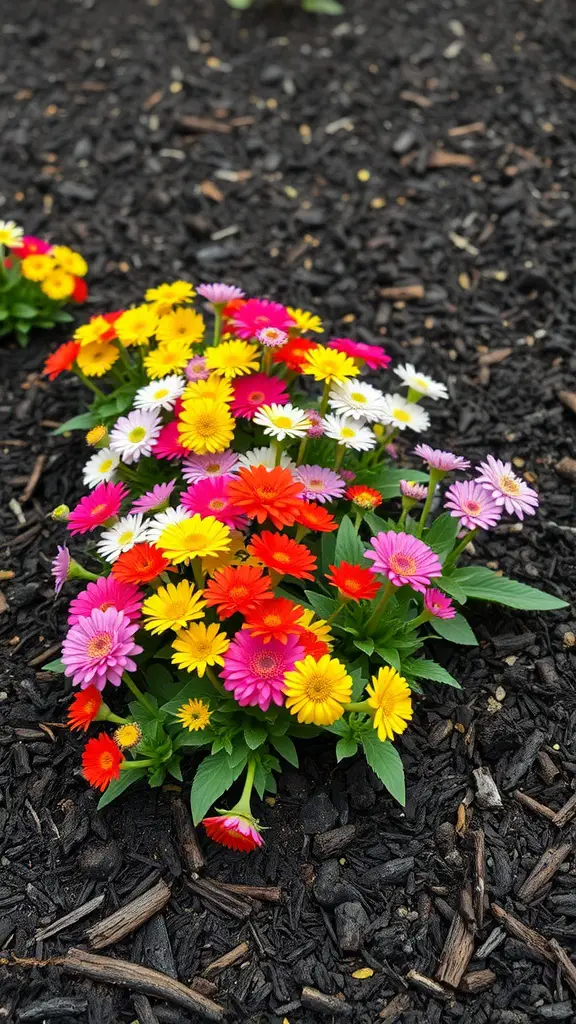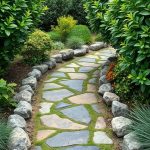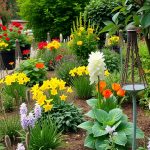If you’re looking to spruce up your outdoor space, mulch can be a simple yet creative way to enhance your landscaping. In this collection of 21 mulch landscaping ideas, you’ll find a variety of styles and techniques that can transform your garden while keeping your plants healthy. From colors to textures, let’s explore how you can use mulch to add interest and curb appeal to your home.
Raised Garden Beds with Organic Mulch
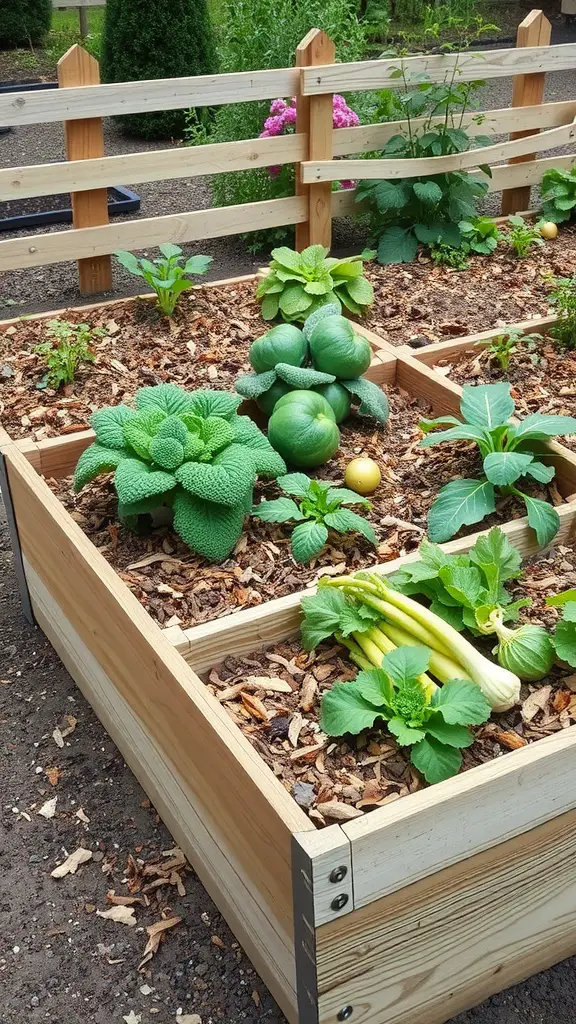
Raised garden beds are a practical and stylish way to grow your plants. In the image, you can see a well-organized setup with wooden frames that create separate sections for different plants. The organic mulch, made from wood chips, serves multiple purposes.
First, it helps retain moisture in the soil, reducing the need for frequent watering. This is especially beneficial during hot summer months. Second, mulch acts as a natural weed barrier, allowing your plants to thrive without competition from unwanted plants.
The vibrant greens of the vegetables peek through the mulch, showing that your plants are healthy and flourishing. This setup not only enhances the garden’s aesthetics but also allows for easier access, making gardening a more enjoyable experience.
Whether you’re planting vegetables or herbs, using organic mulch in raised beds is a fantastic way to support plant health and improve the overall look of your garden.
Pathway Edges Defined with Decorative Mulch
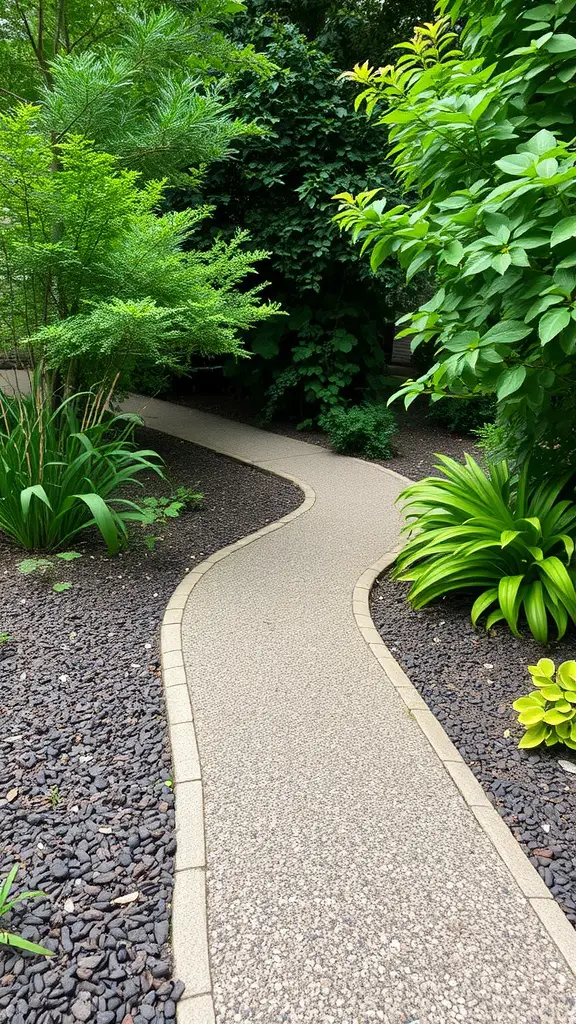
Creating a beautiful garden pathway can transform your outdoor space. In this image, we see a winding pathway edged with decorative mulch. The path is designed with smooth stones, creating a pleasing contrast against the rich black mulch surrounding it.
Using mulch around pathways not only enhances the visual appeal but also helps in weed control. It keeps the garden looking tidy and well-maintained. The lush greenery on either side of the path adds life and color, making every stroll feel refreshing.
Consider different types of mulch to complement your garden’s theme. Whether you prefer organic options like wood chips or colored stones, the right choice can make the pathway pop. Don’t forget to maintain the edges, as clean lines can define the space and guide visitors through your garden.
Mulch Around Trees for Moisture Retention
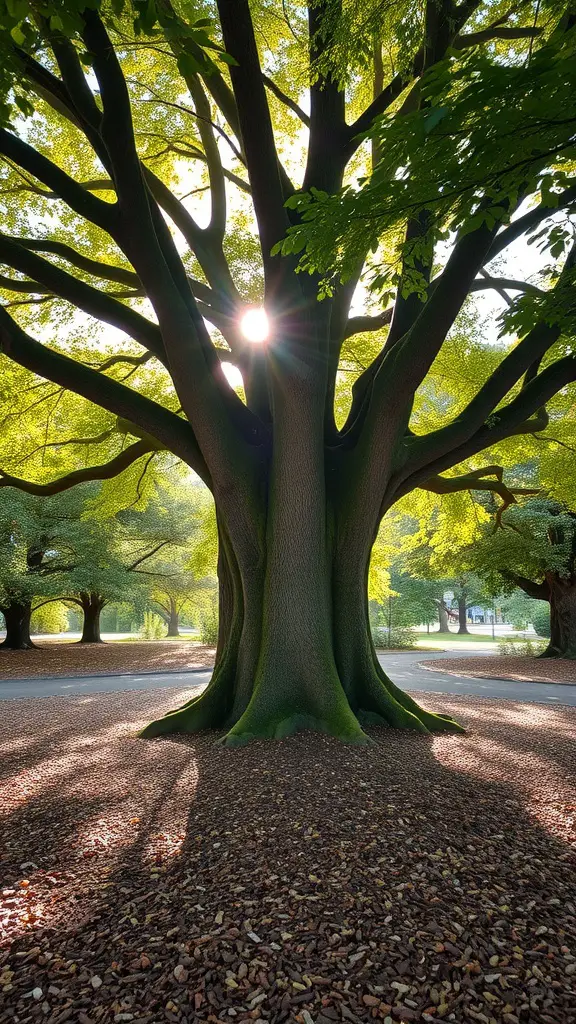
Keeping trees healthy is essential, and one effective way to do this is by using mulch. The image beautifully showcases a majestic tree surrounded by a layer of mulch. This setup not only looks appealing but serves practical purposes.
Mulch around trees helps retain moisture in the soil. When you apply a thick layer of mulch, it acts as a barrier, reducing evaporation. This means your tree will have a steady supply of water, which is vital for its growth and overall health.
In addition to moisture retention, mulch also suppresses weeds. Weeds compete with trees for nutrients and water. By using mulch, you keep those pesky plants at bay while providing a cozy environment for your tree’s roots.
Moreover, organic mulch breaks down over time, enriching the soil with nutrients. This natural process supports the tree’s growth and helps maintain a healthy ecosystem in your yard. So, not only does mulch look nice, but it’s also doing wonders beneath the surface!
Colorful Flower Beds Enhanced with Mulch
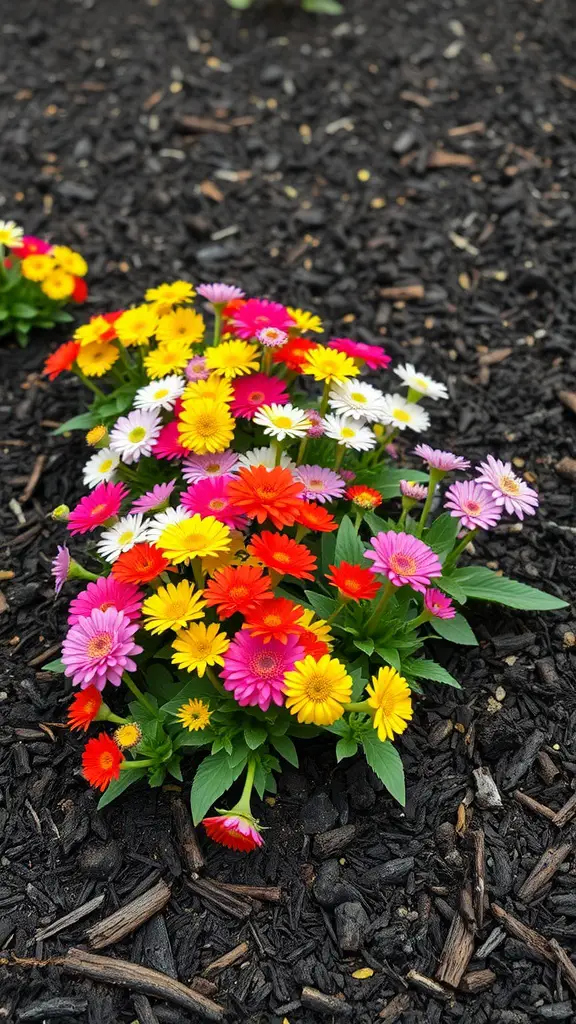
Colorful flower beds bring life to any garden, and when paired with mulch, they create an eye-catching scene. In the image, vibrant flowers in shades of yellow, pink, orange, and white stand out against a dark, rich mulch backdrop. This contrast not only highlights the beauty of the flowers but also adds depth to the overall landscape.
Using mulch around your flower beds has several benefits. It helps retain moisture in the soil, suppresses weeds, and improves soil quality as it breaks down. The dark mulch in the image serves as a perfect canvas, making the bright flowers pop even more. Consider using shredded bark or wood chips for a natural look.
When planning your own flower beds, think about color combinations that will complement the mulch. Grouping flowers with similar hues or mixing contrasting colors can create a dynamic effect. Layering different types of plants can also add interest, giving your garden a lively and welcoming feel.
Mulching not only enhances the aesthetics but also promotes a healthier garden. It’s a simple and effective way to elevate your landscaping. So, get inspired and start designing your colorful flower beds today!
Rock and Mulch Combination for a Modern Look
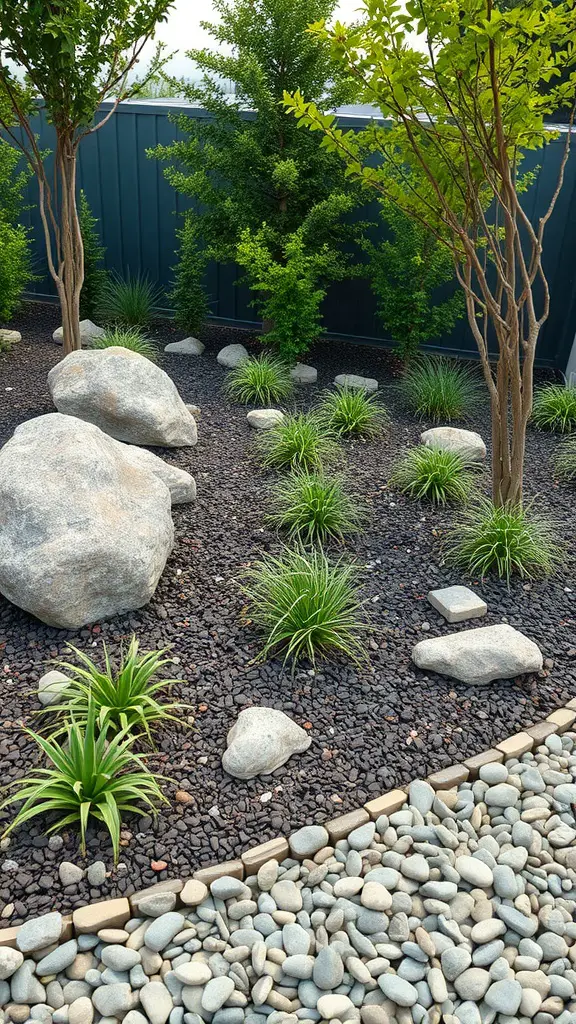
A rock and mulch combination can take your landscaping to new heights. This design blends natural textures and colors, creating a visually appealing and low-maintenance garden. The image illustrates how rocks and dark mulch work together, enhancing the greenery of the plants.
The arrangement of larger stones alongside smaller pebbles adds depth and interest. Notice how the contrasting colors of the dark mulch and lighter stones make the plants pop. This style is perfect for those looking to achieve a sleek, modern look without a lot of fuss.
Additionally, the use of mulch helps retain moisture in the soil while suppressing weeds, making it a practical choice. The rocks can also act as a border, defining the space and keeping everything tidy. Consider adding a few different types of plants for varied textures.
Incorporating this combination not only elevates your outdoor aesthetic but also creates a serene space to relax. Whether you have a small yard or a larger landscape, this idea can easily be adapted to fit your needs.
Mulch as a Weed Barrier in Garden Areas
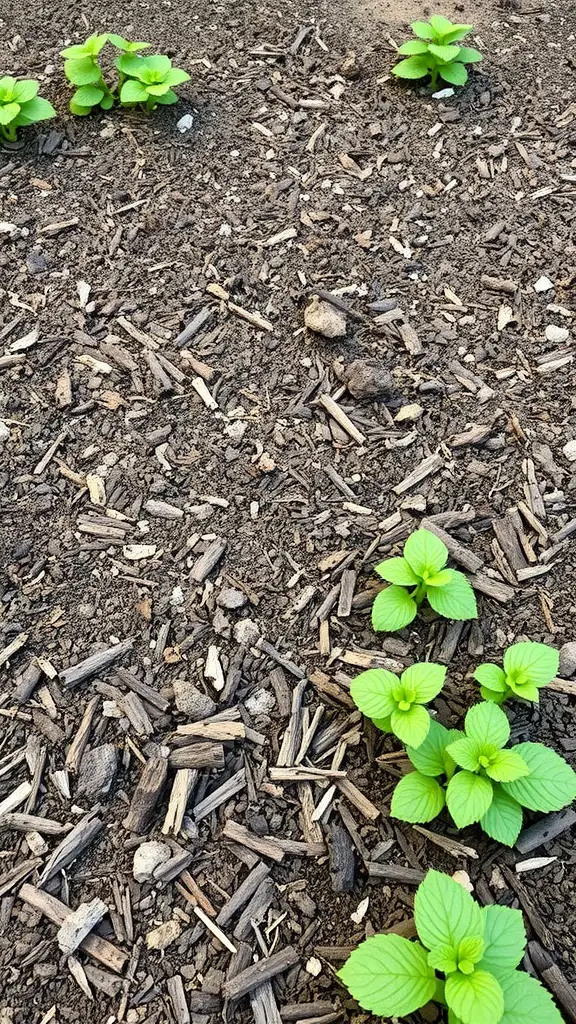
Mulch serves as an effective barrier against weeds in garden areas, simplifying maintenance while enhancing aesthetics. In the image, you can see a neat layout of vibrant green plants surrounded by a layer of mulch. This setup not only looks tidy but also helps keep unwanted weeds at bay.
The wood chips used as mulch create a protective layer on the soil. This prevents light from reaching weed seeds, stopping them from germinating. As a result, your plants can thrive without competition for nutrients and moisture.
Additionally, mulch retains soil moisture, which is beneficial during hot weather. It keeps the roots of your plants cool and hydrated. Over time, as the mulch decomposes, it enriches the soil, contributing to a healthier garden ecosystem.
Using mulch in your garden is an easy way to promote plant growth while minimizing weeding efforts. It’s a practical choice that combines functionality with a pleasing look, making your outdoor space a little more inviting.
Wildflower Gardens Enriched with Mulch Layer
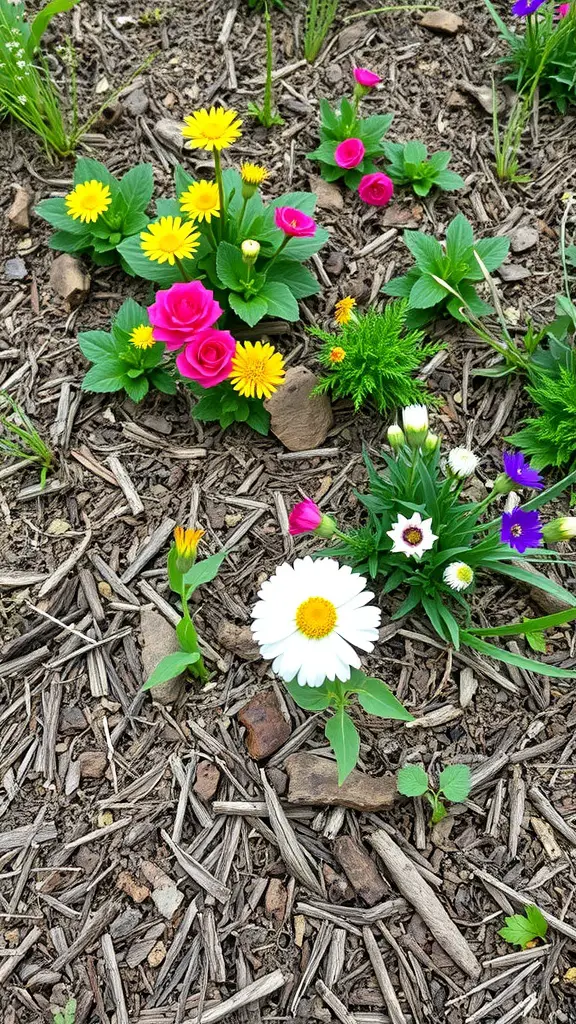
Creating a wildflower garden enriched with a mulch layer is a delightful way to enhance your outdoor space. The image portrays a vibrant array of flowers nestled in a natural mulch bed. This blend not only adds beauty but also supports the health of the garden.
Mulch, composed of organic materials like wood chips, plays a crucial role in keeping the soil moist and healthy. It helps suppress weeds, allowing wildflowers like daisies and roses to thrive. In the picture, the mix of bright colors from various flowers shows how mulch can provide a lovely backdrop.
When planning your wildflower garden, consider the types of flowers you want to plant. Grouping perennials and annuals can create a dynamic look throughout the seasons. The mulch layer will help keep these plants nourished and looking fresh.
Additionally, using mulch can attract beneficial insects to your garden. These insects help with pollination and pest control, leading to a healthier garden overall. So, as you look at those colorful blooms, think about how a good mulch layer supports not just their beauty but their growth too!
Mulch Around Shrubs for a Finished Look
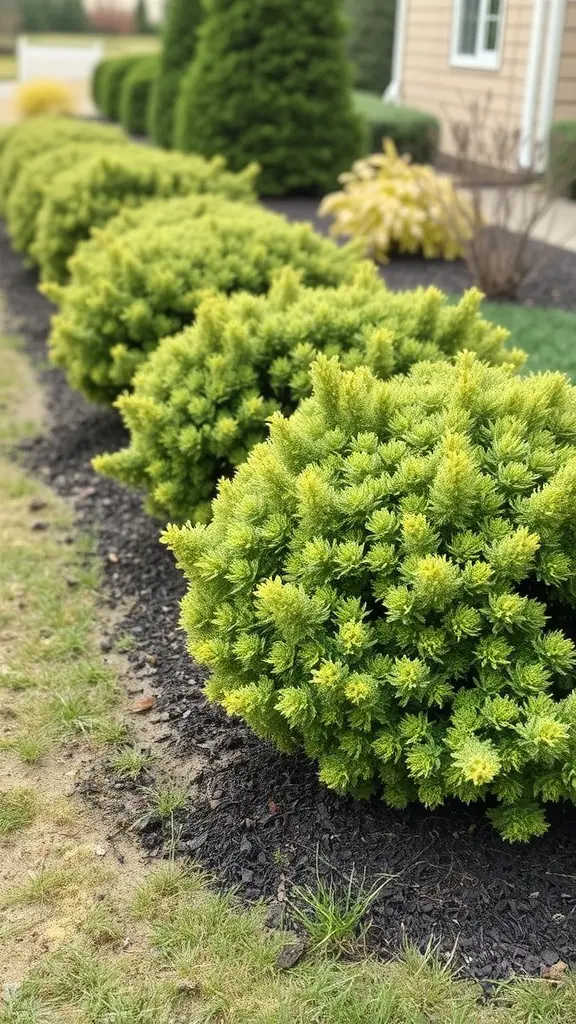
Creating a polished look in your garden is easy with mulch around your shrubs. The image showcases beautiful green shrubs, perfectly rounded and neatly arranged, all enhanced by a rich layer of dark mulch. This combination not only adds a touch of elegance but also makes the garden feel well-maintained.
Using mulch serves multiple purposes. First, it helps retain moisture in the soil, which is crucial for the health of the shrubs. Second, it suppresses weeds that can compete for nutrients. The deep color of the mulch contrasts nicely with the vibrant green of the foliage, making the plants stand out even more. It’s a simple way to elevate your landscaping.
When choosing mulch, consider its type and color. Organic mulches, like wood chips or bark, will break down over time and enrich the soil. Alternatively, synthetic options can provide a clean look and last longer without breaking down. Either way, the goal is to create a neat border around your shrubs that enhances their beauty and helps them thrive.
Contemporary Zen Gardens with Mulch Accents
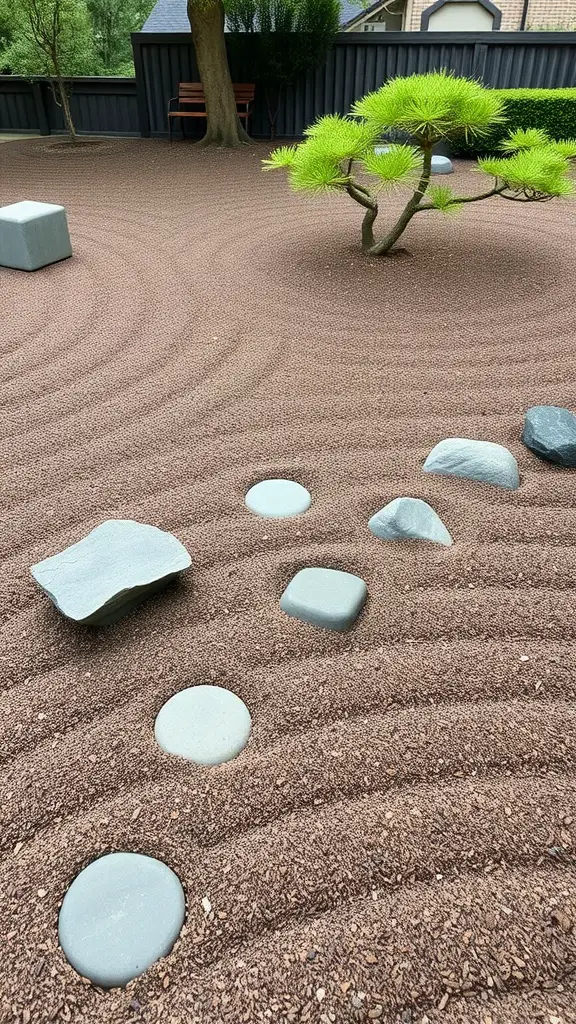
Zen gardens are a beautiful blend of simplicity and tranquility. In this image, you can see a contemporary Zen garden that highlights the calming effects of mulch. The smooth, rounded stones are strategically placed on a bed of finely textured mulch, creating a peaceful layout.
The light brown mulch contrasts nicely with the vibrant greens of the tree, making the space feel alive yet serene. This natural material not only enhances the garden’s aesthetic but also helps retain moisture in the soil, benefiting the plants.
The gentle curves of the mulch provide a sense of flow, guiding the eye through the landscape. Incorporating pieces like benches or additional stones can enhance the usability of the garden, providing spots for reflection or relaxation. This space invites you to take a moment, breathe, and enjoy the beauty of nature.
Mulch Paths for Natural Walkways
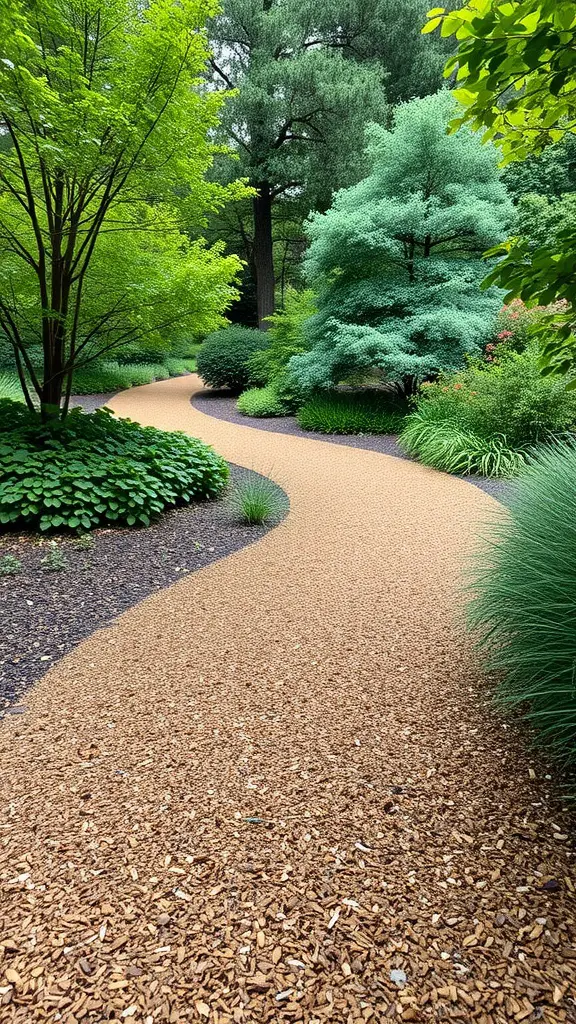
Creating a natural walkway with mulch can beautifully enhance your landscape. In the image, you can see a winding pathway made from mulch, which seamlessly blends with the surrounding greenery. This kind of path invites you to explore the garden while providing a rustic charm.
Using mulch for paths is not only functional but also aesthetically pleasing. It offers a soft surface to walk on and helps with drainage. The warm tones of the mulch complement the vibrant greens of the plants, making the whole area feel cohesive. Plus, it’s easy to maintain; just add more mulch as needed to keep it looking tidy.
Mulch paths are also an eco-friendly option. They can be made from natural materials like wood chips or bark, recycling organic waste while adding beauty to your garden. Whether you have a large yard or a small garden, incorporating mulch paths can enhance the overall look and feel of your outdoor space.
Seasonal Color Changes with Mulch Choices
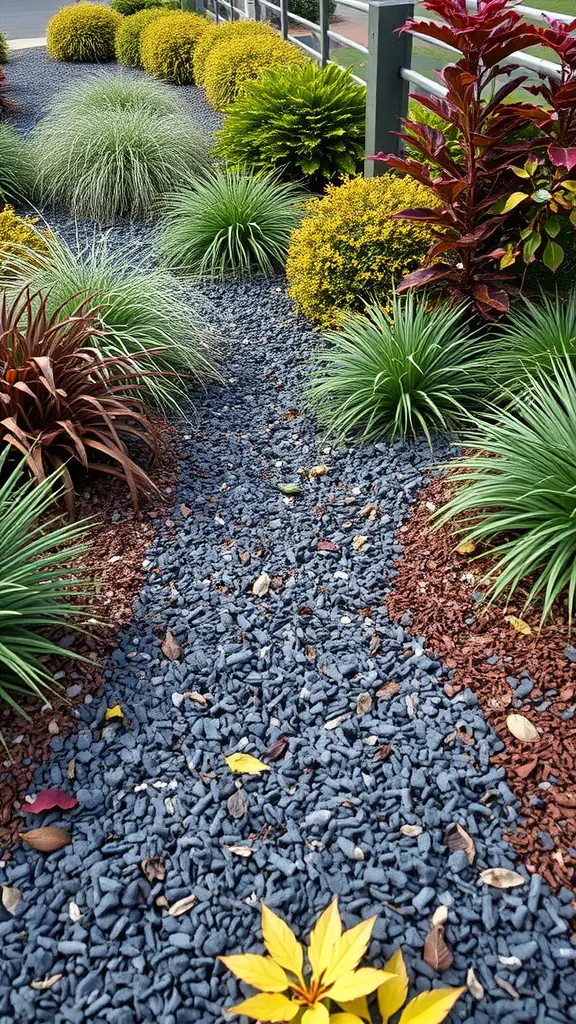
When it comes to landscaping, mulch isn’t just practical; it’s a canvas for color. Look at the image above, where different types of mulch create a striking contrast with the vibrant plants. The dark blue stones blend beautifully with the rich reds and greens of the foliage, showcasing how mulch can enhance seasonal color changes.
In spring and summer, the lively greens of the plants pop against the dark mulch, making your garden look fresh. As fall approaches, the colorful leaves scattered on the ground bring warmth and contrast, while the mulch still provides a consistent backdrop.
Choosing the right mulch can also affect how your garden looks in winter. Darker mulches can create a cozy feel against the starkness of winter. Meanwhile, lighter mulches can reflect sunlight, brightening up the space even on cloudy days. This flexibility allows for a garden that looks good year-round.
So, when planning your garden, think about how your mulch choice can play a role in the seasonal changes. It’s not just about what’s planted; it’s about how everything works together for a beautiful landscape.
Eco-Friendly Mulch Options for Sustainable Landscaping
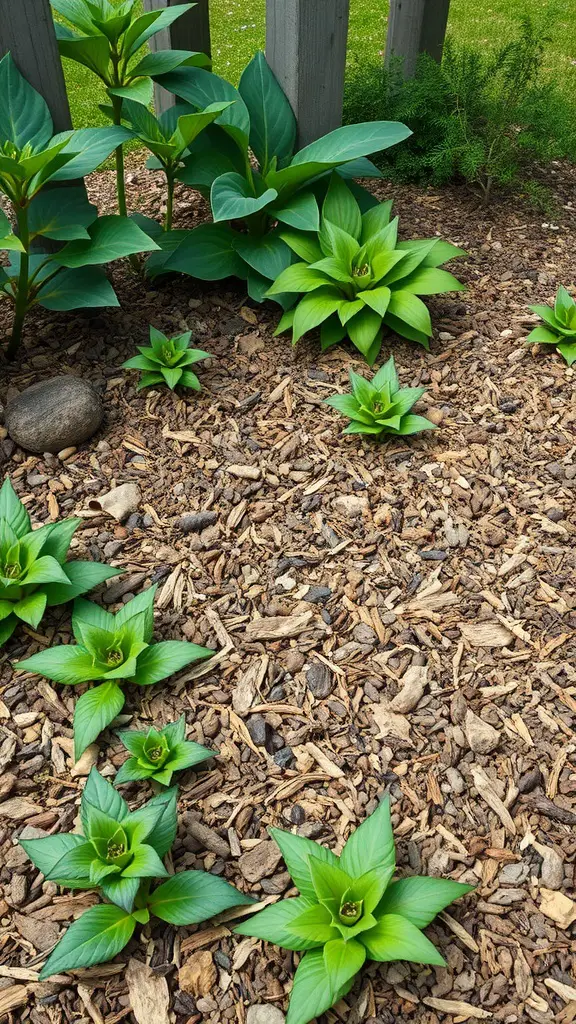
When thinking about mulch for your landscaping, consider eco-friendly options that benefit both your garden and the environment. The image here showcases a beautiful garden bed featuring vibrant green plants surrounded by natural mulch. This setup not only looks inviting but also supports sustainable practices.
Using organic mulch like wood chips or bark enhances soil health as it breaks down over time, enriching the ground. This mulch retains moisture, reduces weed growth, and provides a cozy habitat for beneficial insects. Plus, it gives your plants a stylish backdrop!
You might also explore other eco-friendly options like straw or grass clippings. These materials are often readily available and can easily be added to your garden. Just remember to compost them to make the most out of their benefits.
Mulched Vegetable Gardens for Optimal Growth
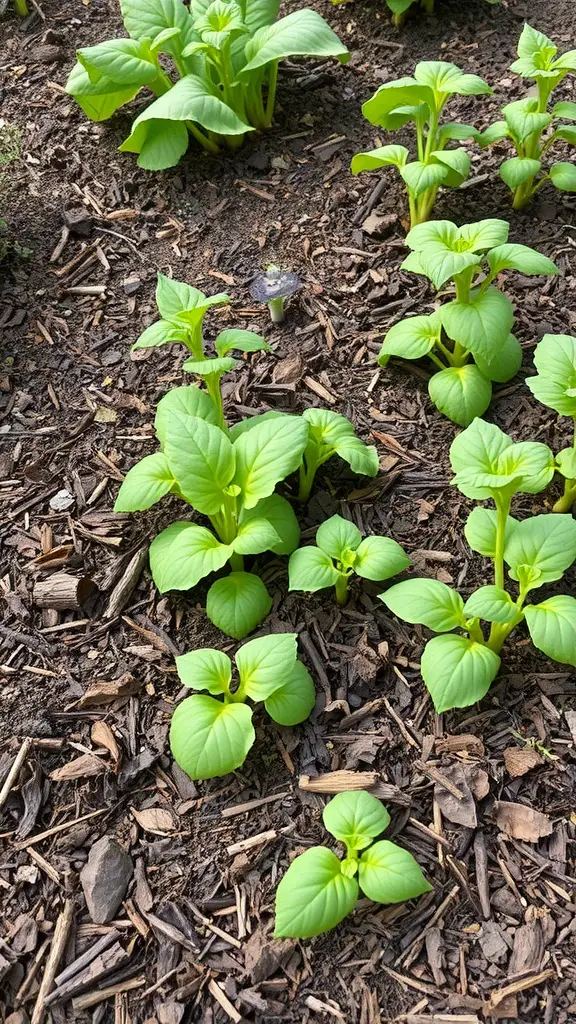
Mulching your vegetable garden is a simple yet effective way to promote plant health. In the image, you can see vibrant green young plants growing amidst a layer of mulch. This setup not only looks tidy but also plays a crucial role in the growth of these vegetables.
Using mulch, like wood chips or straw, helps retain soil moisture, ensuring that your plants have a steady supply of water. This is particularly important for young seedlings, as their roots are still developing. A well-mulched garden can mean less frequent watering, saving you time and effort.
Additionally, mulch acts as a barrier against weeds. By covering the soil, it restricts weed growth, giving your vegetables a better chance to thrive without competition. In this image, the clean spaces around the plants indicate that the mulch is doing its job, allowing these seedlings to flourish without the worry of invasive weeds.
Moreover, mulch can also improve soil quality over time. As it breaks down, it adds organic matter back into the soil, enriching it and promoting healthy microbial activity. This creates a vibrant ecosystem, ideal for vegetable gardening.
So, whether you’re planting a few vegetables or creating a larger garden, consider incorporating mulch. It’s a simple step that can lead to healthier plants and a more productive garden.
Cottage Garden Charm with Mulch
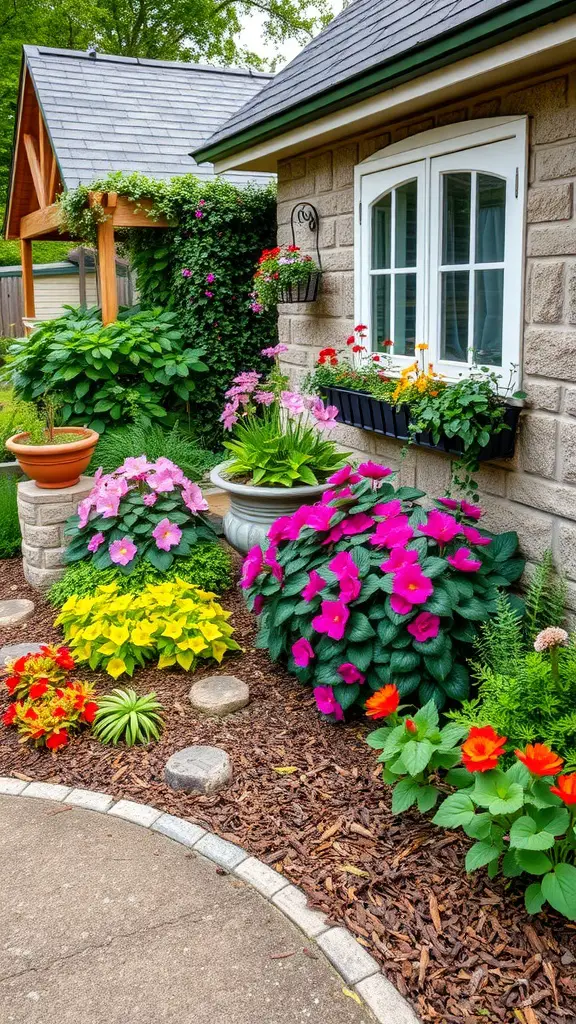
A cottage garden is all about charm and coziness, and mulch plays a vital role in achieving that look. The image captures a delightful scene filled with vibrant flowers and lush greenery, creating a warm and inviting atmosphere. Rich brown mulch surrounds the plants, adding contrast to the colorful blooms and helping retain moisture in the soil.
The flowers, including bright pinks and sunny yellows, pop against the earthy tones of the mulch. This combination not only enhances the aesthetics but also serves practical purposes, like weed control. The neatly arranged stones along the path highlight the garden’s structure, guiding visitors through the delightful scenery.
Incorporating mulch in a cottage garden design is a simple yet effective way to elevate its charm. It allows for a more polished look while providing essential benefits for plant health. Whether you choose wood chips, bark, or straw, mulch brings a rustic feel that complements the overall cottage theme beautifully.
Maintaining Mulch for Longevity and Health
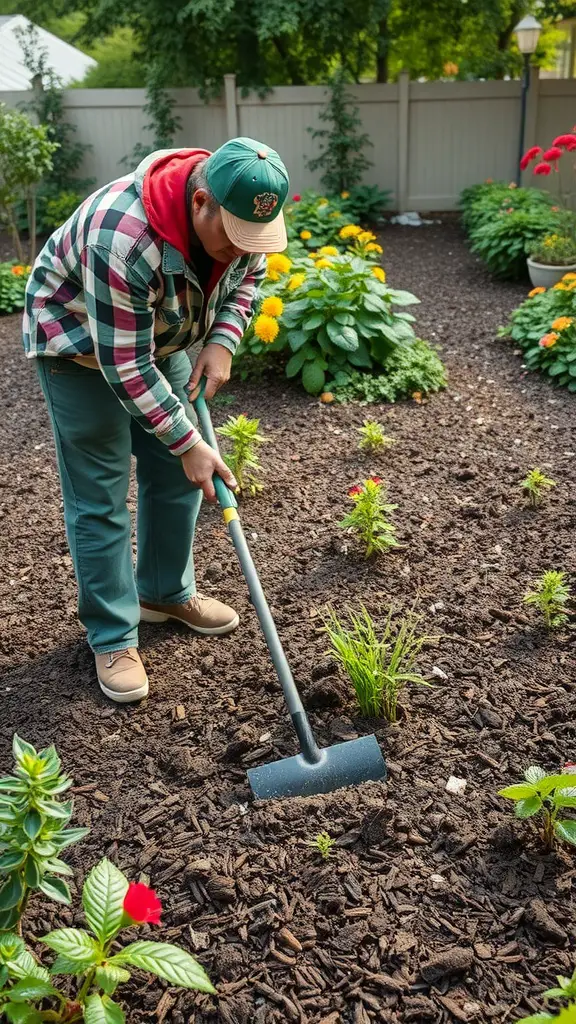
Mulch plays a crucial role in keeping your garden healthy and vibrant. As seen in the image, a person is diligently working in their garden, using a tool to manage the mulch around the plants. This hands-on approach is essential for maintaining the garden’s aesthetics and plant well-being.
Regular maintenance of mulch can prevent weed growth and help retain moisture in the soil. It’s like giving your plants a cozy blanket! When you spread mulch evenly, you’re not only enhancing the look of your garden but also protecting your plants from temperature extremes.
It’s important to check for any signs of decomposition. Over time, mulch can break down and lose its effectiveness. If you notice any areas looking sparse or less vibrant, it’s a good idea to add a fresh layer. Aim for about 2 to 3 inches of mulch for optimal coverage.
Also, remember to keep mulch away from the stems of your plants. Piling it too high can lead to rot. Instead, create a small gap around each stem. This simple tip will promote healthier growth.
Lastly, consider the type of mulch you’re using. Different materials have different lifespans and benefits. Organic mulches, like wood chips or bark, decompose over time, enriching the soil. In contrast, synthetic mulches can last longer but may not provide the same benefits.
